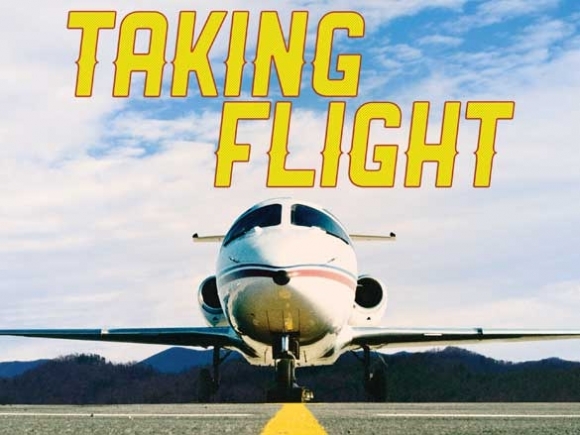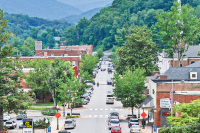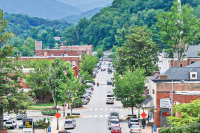Another runway extension in the wings for Macon airport

With the last Macon County Airport runway extension project barely in the rearview, the North Carolina Department of Transportation has approved another $4.5 million airport project to make the runway even longer.
The last expansion project in 2011 extended the runway from 4,400 feet to 5,000 feet for safety reasons — the same reason why local officials say the runway now needs to be expanded to 6,000 feet.
“It’s still four to six more years until it actually happens, but it’s in the pipeline,” said Miles Gregory, chairman of the Macon County Airport Authority.
Though the project is still years away from construction, it is included in NCDOT’s newly released 10-year transportation plan. Macon County Board of Commissioners unanimously approved a 10 percent local match for the project last month, marking the second time the county has contributed $450,000 toward a runway extension project in the last five years.
Commission Chairman Jim Tate, who served as the board’s liaison to the airport authority for many years, said he was excited about what the future expansion will mean for Macon County and the rest of the region.
“It will be great for Western North Carolina to have an airport of that capacity,” he said. “The airport usage has gone up consistently every year since I’ve been on the board and it continues to grow.”
Related Items
Gregory said the 1,000-foot expansion was needed to improve safety and make the airport accessible to more types of aircraft. While the last extension has helped increase traffic into the small airport in the Iotla Valley, he said landing is still difficult for most planes.
“Traffic has increased considerably since we did the extension to 5,000 feet — pilots have no trouble taking off now but landing is still a problem,” he said. “They’re burning out their brakes trying to get stopped so this will be an added safety feature.”
Costly investment
The county, state and federal taxpayer money that has gone into maintaining and improving the Macon County Airport has been substantial.
In addition to the $900,000 worth of local contributions made to runway expansion projects, the county has also approved annual funding to the Macon County Airport authority for capital improvements and other DOT improvement projects.
 In 2013, commissioners narrowly approved allocating $290,000 to the airport authority so that it could leverage a $2.5 million Federal Aviation Authority grant. The grant covered the cost of expanding the width of the runway from 75 feet to 100 feet, repaving the runway and adding new lights along the airstrip.
In 2013, commissioners narrowly approved allocating $290,000 to the airport authority so that it could leverage a $2.5 million Federal Aviation Authority grant. The grant covered the cost of expanding the width of the runway from 75 feet to 100 feet, repaving the runway and adding new lights along the airstrip.
The county allocates between $40,000-$50,000 a year for airport operating expenses and occasionally assists with capital improvement costs. Over the last three years alone, the county has allocated more than $420,000 for the airport in the annual budget.
While some taxpayers think the money is well spent considering all the benefits the airport provides, others think only a select few are actually benefitting from the millions being poured into the airport.
“Commissioners have been tremendously supportive of the airport, but it’s not a cost to the county — it’s an investment — a good investment,’ Gregory said. “If we’re going to have an airport we need to have the best one we can afford — it will pay off.”
While the current commissioners approved the $450,000 match, it could be a future board in four to six years that actually has to give the money. Tate said the current board wouldn’t put a future board on the hook for that kind of money if it didn’t think it was in the best interest of the entire county.
“Probably the biggest complaint I’ve heard from people is ‘we don’t have an airplane so it doesn’t help us any,’ but indirectly it affects all Macon County residents. Our largest employers use it on a daily basis, and those businesses would move elsewhere without the airport,” he said. “This decision will affect the county budget for several years, but it’s an important thing to do for the good of the county overall.”
Economic development
Gregory can share a number of anecdotal stories that show the economic benefits that come with having an airport in Macon County.
“Last year a jet came in on a Thursday and four teenaged girls got off. I talked to the pilot who was from Kentucky and he flew them here from the university to the Old Edwards Inn for a wedding — there are several incidents like that — those people pay a good deal of taxes while they’re here,” Gregory said.
Those people pay property tax on their second homes or they rent hotels and pay the occupancy tax, they buy groceries and they pay sales tax when they shop in Franklin and Highlands. Gregory also pointed out that plane owners pay a hefty personal property tax to the county, which goes into the county budget every year.
Cherokee and Harrah’s Casino also benefit from the airport. Many of the casino’s big musical acts use the airport, including Tony Bennett.
“Lots of second home owners use the airport and in fact, 50 percent of the airport usage has a final destination of Highlands and Cashiers,” Tate said.
The Macon County Airport may only employ a handful of people, but it helps support hundreds of jobs in Macon County.
Companies like Drake Enterprises that employ 900 people and Duotech Services that employs 50 people can speak to the advantages of having an airport close by.
Duotech owner Dan Rogers said the airport is essential to his defense company that needs to fly its technicians and engineers all over the country to meet with customers. Being able to fly out of Macon County on a private jet cuts down on his trip time compared to flying commercially.
“From a business standpoint the airport is invaluable — especially when the closest airports are hours away in Atlanta or Charlotte — you really can’t put a price on it,” Rogers said.
 Drake CEO Phil Drake said the airport allows his business to visit multiple cities in one day.
Drake CEO Phil Drake said the airport allows his business to visit multiple cities in one day.
“Some weeks we fly six days. Some days we go to two or three different locations returning to Franklin on each leg,” Drake said. “My pilot recently had a day that he was in Myrtle Beach, Teterboro, New Jersey, and Cincinnati, Ohio, in the same day, which would be impossible without the airport in Macon County.”
Drake employees specifically travel to Washington, D.C., and Nashville, Tennessee, often. Because of the Macon County Airport, they can make stops in both cities in one day and still make it home for dinner in Franklin. The airport allows employees to have the high quality of life offered in Macon County while also having a high-tech job that typically requires you to live in more urban areas.
“If we had to fly out of Asheville or Atlanta, it would take three days because we would have to fly out the day before a meeting, and then fly home the day after,” Drake said. “So it is not at all practical for us to fly commercially to those cities.”
Both companies said the airport was not a major factor when deciding to open a business in Macon County — mostly because the airport was still fairly primitive. But Drake said it is a major factor in whether the company can stay in Macon County in the future.
Gregory said the airport helps existing businesses and is something potential industries are looking for when they select a location to set up shop. Having the airport gives Macon County a better shot at landing new jobs.
“This is for future development — this airport will be a tremendous asset to Macon and Jackson and Swain counties, and also Rabun County (Georgia) because it’s centrally located and offers better facilities,” he said. “We need it to fly officials here to check out different spots — if we don’t have an airport, we’re out of the picture completely.”
Safety concerns
The question remains — does adding another 1,000 feet to the runway really make that much of a difference as far as safety is concerned?
Macon County Airport’s runway is already longer than Jackson County Airport’s 3,200-foot runway and is only slightly shorter than Andrews/Murphy Airport’s 5,500-foot runway.
But local pilots say it will make landing much safer and will also enable more types of planes and jets to utilize the airport.
Drake, CEO of Drake Enterprises, and his pilot David Phillips use the airport on almost a daily basis.
Phillips said the expansion from 5,000 feet to 6,000 would improve safety conditions, especially while flying at night and during heavy rain and fog.
“You should sit up front in the cockpit one dark and rainy night and get a firsthand look at why it would be so much safer with the additional 1,000 feet added to the runway,” he said. “The approach speeds in the Citation CJ2+ jet can be as high as 135 miles per hour. The runway looks really short at night in the rain.”
Duotech CEO Dan Rogers has used the airport for his business travel since 1989. He said the previous runway expansion project has been helpful in improving safety for pilots. Larger jets also need more runway space to land compared to smaller single-engine planes.
“From a safety standpoint, it gives you plenty of buffer for the pilots trying to land,” he said.
 The expansion from 5,000 to 6,000 won’t make much of a difference for Rogers’ landings, but he said it would open up the airport for more private jet traffic. For example, he said XOJET, which provides private jet charter trips, is interested in utilizing the Macon County Airport but can’t right now because of the runway length.
The expansion from 5,000 to 6,000 won’t make much of a difference for Rogers’ landings, but he said it would open up the airport for more private jet traffic. For example, he said XOJET, which provides private jet charter trips, is interested in utilizing the Macon County Airport but can’t right now because of the runway length.
“For my purposes it’s not a big difference, but nowadays you have commercial flights coming in here from NetJets and others that fly individuals from one place to another and those jets need 5,000 to 6000 feet of runway,” he said. “The amount of peripheral business the airport brings in is hard to measure.”
There have been two incidents within the last 20 years at the Macon County Airport that resulted in death. Back in 1995, a husband and wife crashed trying to land on the runway. In 2012, another plane crash near the airport killed the five people on board.
Gregory said both of those incidences might have been avoided if the runway was longer at the time.
“In 1995, that couple went into the field and flipped — that would not have happened if we had the runway extended,” he said.
However, a report from the National Transportation Safety Board indicated that the runway length had nothing to do with the crash. The cause of the crash was determined to be a “the pilot’s failure to maintain flying speed resulting in an aerodynamic stall. A factor was sun glare,” according to the report.
Split on support
The expansion and improvement projects at the airport haven’t exactly been met with enthusiasm from the entire community.
Before the last runway extension project was formally approved, several residents in the Iotla Valley near the airport were adamantly opposed to the project because they thought it would mean more disturbing vehicle and air traffic in the area.
While the board was unanimous in the latest vote to expand the runway, commissioners were divided on the previous runway project. Commissioner Paul Higdon and former commissioner Ron Haven voted against providing the $290,000 matching funds in 2013 for the repaving and widening project. For Haven, the airport just didn’t clearly show the economic benefits the project would have for all residents of Macon County.
Even more controversial was when the airport authority and commissioners began discussing lengthening the runway from 4,400 feet to 5,000 feet back in 2009. With Cherokee burial sites and artifacts surrounding the airport property, the Eastern Band of Cherokee Indians was not happy with how Macon leaders were handling the sensitive expansion project.
The authority agreed to remove 25 percent of artifacts on the site, but Cherokee wanted 100 percent removed. They authority claimed it would cost too much — estimated $2 million — to remove all the artifacts and instead contracted with TRC Environmental of Chapel Hill to recover 25 percent of the artifacts for $535,000.
Several residents threatened lawsuits because of the project, but nothing ever came to fruition and the project was completed in 2011 after working through a lengthy environmental permitting process with the U.S. Army Corps of Engineers.
Despite the concerns about the increase in vehicle and air traffic in the rural community, Gregory said he hasn’t heard any complaints since the expansion was completed nearly five years ago. He said many people in the county couldn’t even tell you where the airport is located because they never notice the air traffic, which mostly occurs between Thursday and Sunday.
“Of course you have some people who’d rather have it somewhere else, but we can’t move it,” Gregory said.
Macon County Airport history timeline
• 1969 — Macon County airport was opened under county ownership.
• 1995 — A husband a wife died in a plane crash trying to land at Macon County Airport.
• 1998 — The North Carolina General Assembly established the Macon County Airport Authority and the county deeded the land and facilities over to the authority. Peggy Milton and Neil Hoppe, owners of Franklin Aviation, received a 20-year contract from the county to manage Macon County Airport — that contract expires in 2018.
• 2009 — Macon Airport Authority receives criticism over a proposed runway extension from 4,400 feet to 5,000 feet after an archaeological assessment called the site one of the more significant areas in the state because of some 400 Cherokee burials and artifacts.
• 2011 — The 600-foot extension to the runway at Macon County Airport is completed to the tune of $4.5 million. The project was paid for with a combination of federal, state and local dollars.
• 2012 — A plane crash at the Macon County Airport kills five people.
• 2013 — Macon County commissioners narrowly approve providing a $290,000 local match in order to get a $2.5 million grant from the FAA and DOT to repave and widen runway from 75 feet to 100 feet.
• 2016 — DOT wants to complete another $4.5 million expansion project to lengthen the runway from 5,000 feet to 6,000 feet. Commissioners voted unanimously to support the project, which will require another 10 percent match — $450,000 — from local coffers.
By the numbers
• The Macon County Airport has an annual economic impact of $12.2 million.
• The airport supports 110 jobs with an annual payroll of $1.8 million
• Macon County taxpayers have paid for the following airport projects
— $450,000 for an airport extension in 2011
— $290,000 for repaving and widening 2013
— $450,000 for next runway extension 2016
Source: N.C. DOT Division of Aviation 2016 study
Macon County contributions to Macon County Airport Authority
Fiscal Year Operating Expenses Capital Expenses TOTAL
FY 16-17 $53,800 N/A $53,800
FY 15-16 $43,000 $283,334 $326,334
FY 14-15 $40,000 N/A $40,000
Airports’ impact on North Carolina’s Economy
Seventy-two publicly owned airports in North Carolina are supported annually with funds from the state for infrastructure and development projects. According to the 2016 Division of Aviation report, airports contribute:
• $31 billion annual economic impact
• 123,400 airport-related jobs
• $913 million in direct government revenue
North Carolina aviation serves everyone in our state. The economic reach of airports extends far beyond pilots and operators by supporting:
• Time-sensitive, high-value cargo and freight transport
• People, both for business and pleasure travel
• Fire fighting and medical emergency
• Search and rescue
• Military
• Agriculture
• Aerospace industry
• Tourism









